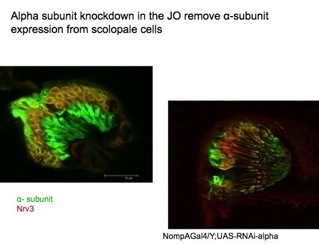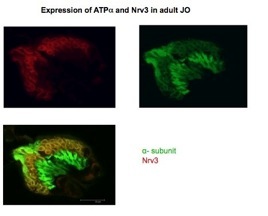Madhuparna Roy

Immunohistochemistry from NompAGal4 driven alpha-subunit knockdown animals show lack of alpha subunit expression in the scolopale space of the chordotonal neurons.
EM indicates that these animals also have morphological defects such as abnormal accumulation of electron dense material in the scolopale space including accumulation of membranous bodies such as mitochondria.
Our results indicate ATPα is primarily important for scolopale cell function with a putative neuronal role, while nrv3 is required in neuron with a possible role in the scolopale cell.

EDUCATION:
BS - Vishva-Bharati University
MS - University of Calcutta
current Position:
PhD Candidate
PROJECT:
nrv3
NA+/ K+ ATPase and its role in fly hearing


The plasma membrane-localized Drosophila Na+/K+ ATPase is dependent on the beta subunit for its transport to the plasma membrane and for regulating its activity. Two beta subunits have been characterized in detail, nervana 1 and nervana 2, which are both expressed broadly in the nervous system and epithelia. In situ hybridization in embryo shows that a third beta subunit, nervana 3 (nrv3), is expressed in a subset of CNS neurons and, peripherally, in chordotonal organ neurons. This expression pattern suggested the possibility that nrv3 could be important for hearing, mediated by the antennal chordotonal array called Johnston’s organ. We currently have three nrv3 mutant alleles, nrv315, nrv347 and nrv3f04395. All nrv3 alleles result in homozygous lethality at early larval stage.
Our immunohistochemical studies in late stage embryos show that the alpha subunit localizes to the plasma membrane of CNS neurons, while Nrv3 localizes to the PNS, especially the lateral pentascolopidial organ (lch5), as well as a subset of the CNS. These data agree with our in situ hybridization studies. Immunohistochemical studies in adults show localization of Nrv3 protein in the brain, eye and chordotonal neurons in Johnston’s organ (RIGHT).
We are using the UAS/Gal4 binary system to tissue specifically knockdown the Na+/K+ATPase subunit expression, with inducible UAS-RNAi. Ubiquitous knockdown of nrv3, using sqh-Gal4 resulted in severe adult uncoordination and early mortality in the experimental animals. Antennal electrophysiological recordings from such animals indicated significant reduction in auditory response. RNAi knockdown of nrv3 with atonalGal4, which affects all of Johnston Organ results in complete deafness. However, RNAi knockdown of nrv3 only in the supporting cells or scolopale cells using NompAGal4 causes a mild hearing defect.
We have also looked at UAS-RNAi knockdown of the pump subunit (alpha-subunit) using atonal and NompAGal4 drivers. UAS-RNAi mediated elimination of alpha subunit with either driver results in complete deafness (LEFT).


Contact:
